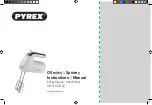
13
LINE IN
Point Before: Balanced or unbalanced mic- or
line-level cable with
1
⁄
4
" TRS or TS connector,
(tip = hot, ring = cold, sleeve = shield).
Point After: Channel
.
This input is similar to the
MIC
input,
but without phantom power. Both signals mix
together at the mic preamp. Mic-level signals
can be accommodated here with up to 40dB of
gain. The
LINE IN
is 20dB less sensitive than
the
MIC
input.
Do not use this input simultaneously with its
associated
MIC
input. Turn
TRIM
down
and engage
MUTE
before inserting or re-
moving line cables. Do not use open-ended TRS
cables (signal on tip, ring open) unless the ring
is first tied to ground (sleeve). It won’t hurt
anything, it will just work better if you ground
the sleeve. Although you can connect a micro-
phone to this input, there will be less noise
when connected to the
MIC
input jack.
INSERT SEND AND RETURN
Point Before: Channel mic/line preamp,
TRIM
,
0/
(Polarity Reversal)
,
HPF
.
Point After:
EQ
.
Both the
INSERT SEND
and
INSERT
RETURN
jacks are balanced, and can also
accommodate unbalanced TS cables. Signal
feeding the
INSERT SEND
jack is also sent to
the
INSERT RETURN
jack’s normalling pins.
With nothing plugged into the
INSERT
RETURN
jack, the (dry) send signal will be
passed along to the rest of the channel path
(this is called half-normalled).
To insert a serial effects device, simply patch
from the
INSERT SEND
jack to the effect’s in-
put, and from the effect’s output to the
INSERT
RETURN
jack, using either balanced TRS or
unbalanced TS cables.
Since using the
INSERT SEND
jack by it-
self does not interrupt the channel’s signal
path, it may also be used as a pre-
EQ
/pre-
Fader direct output, in addition to the
post-Fader
DIRECT OUT
.
DIRECT OUT
Point Before: Channel signal,
EQ
, Chan-
nel Fader
,
MUTE
.
Point After: Balanced or unbalanced cable
with
1
⁄
4
" TRS or TS connector.
The
DIRECT OUT
’s signal is the same as the
output of the Channel, except that the
PAN
control has no effect.
These jacks can be used to feed multitrack
recorder inputs, as a one-channel effects send,
as a secondary sound source’s trigger com-
mand, or for any other purpose that requires
the post-Fader signal of an individual Channel.
Using this jack does not interrupt the
Channel’s signal path to the output section.
MAIN INSERTS
(BAL/UNBAL)
HEADPHONES
R
L
LEFT RETURN
2
1
4
3
6
5
8
7
R
R
R
R
L
L
L
L
RIGHT SEND
LEFT SEND
MONITOR
(BAL/UNBAL)
AUX SEND
(BAL/UNBAL)
"B" AUX RETURNS
(BAL/UNBAL)
1
2
3
4
(MONO)
(MONO)
(MONO)
(MONO)
R
R
R
R
L
L
L
L
A1
A2
A3
A4
(MONO)
C
A
D
B
(MONO)
(MONO)
SOURCE =
MASTER L-R
SOURCE =
MATRIX C&D
(MONO)
MATRIX D
MATRIX C
MATRIX B
MATRIX A
CENTER
RIGHT
INSERT RETURN
MIC 24
INSERT SEND
24
DIRECT OUT
LINE IN
TAPE
TAPE
R
L
R
L
R
L
R
L
INPUT
OUTPUT
TAPE
TAPE
INPUT
OUTPUT
TAPE A
TAPE B
TALKBACK
MATRIX OUTPUTS
MATRIX INPUTS
MAIN OUTPUTS
CNTR SEND
RIGHT RETURN
CNTR RETURN
L-INSERT
R-INSERT
TAPE
MAIN AUX RETURNS














































